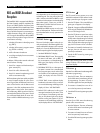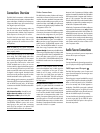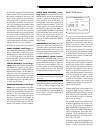
27
An alternative configuration for setting up front
SMALL speakers with a subwoofer is to follow
the speaker manufacturer’s instructions, wir-
ing the SMALL speakers to the subwoofer’s
crossover and then connecting the subwoofer
directly to the front speaker connection termi-
nals. In this arrangement, the speakers would
be classified as LARGE and the subwoofer
setting would be OFF for all surround modes.
No information will be lost during playback
because the system knows to redirect the bass
information to the front LARGE speakers. This
configuration may improve the way the bass
integrates into the listening room and ensure
correct satellite speaker operation by using the
speaker manufacturer’s own crossovers.
The following speaker options are available:
FRONT SPEAKERS (small/large): This
menu setting determines what kind of main front
left and right speakers you are using. Use the
LARGE setting if your main left and right speak-
ers are full range designs with good bass
response capability. If you are using minispeak-
ers, use the SMALL setting.
CENTER SPEAKER(S) (small/large/
none): Use the LARGE position (not available
with SMALL front speakers) if your system’s
center channel speaker is capable of full-range,
extended bass response. Use the SMALL po-
sition if your center channel speaker has more
limited low frequency capability, or if you prefer
that the bass be sent to the subwoofer. Select
the NONE setting if your system does not have
a center channel speaker.
SURROUND SPEAKERS (small/large/
none): If your surround speakers are capable
of sustained low frequency output, select the
LARGE setting (not available with SMALL front
speakers). If your rear speakers have limited
bass capability or if you would prefer that the
bass go to a subwoofer, use the SMALL set-
ting. If your system has no rear surround speak-
ers, select the NONE setting (surround infor-
mation will be added to the front speakers).
English
CENTER BACK SPEAKER(S) (small/
large/none): Some systems have one or two
additional center back surround speakers for
use with 6.1 channel surround signals or 7CH
stereo processing. With the RSX-1065, such
a configuration is available using the preamp
outputs and external amplifiers. If your cen-
ter back speakers are capable of sustained
low frequency output, select the LARGE set-
ting (not available with SMALL front speakers).
If your side speakers have limited bass capa-
bility or if you would prefer that the bass go
to a subwoofer, use the SMALL setting. If your
system has no center back speakers, select the
NONE setting.
SUBWOOFER (yes/no/max): Use the YES
setting if your system has a subwoofer. If your
system does not have a subwoofer, select NO.
Select the MAX setting to redirect all low fre-
quency information from all speakers (includ-
ing LARGE speakers) to the subwoofer.
CB SPKR SELECT (1 speaker/2 speak-
ers): Use the 1 SPEAKER setting if your sys-
tem has a single center back surround speaker.
Use the 2 SPEAKERS setting if your system has
2 center back surround speakers. If your sys-
tem does not have any center back speakers,
select NONE on the previously described
CENTER SPEAKER setting on this menu.
NOTE
: Speaker configuration is a global set-
ting for all surround modes and need only be
done once.
To change a setting, place the highlight on the
desired line using the UP/DOWN buttons and
use the +/– buttons to toggle through the
available settings. To return to the MAIN menu,
press the ENTER button. Press the MENU key
on the remote to cancel the display and re-
turn to normal operation.
DELAY SETUP Menu
DELAY SETUP
Dolby D Dolby
/DTS Pro LogicII
CENTER: 01ms
R SURROUND: 15ms 30ms
L SURROUND: 15ms 30ms
CNTR-BACK: 15ms
ENT KEY=MAIN MENU UP KEY=up
+/– KEY=change DWN KEY=down
This menu, which is reached from the MAIN
menu, allows you to set the delay for individual
speakers. This ensures that the sound from each
speaker arrives simultaneously at the listening
position, even when the speakers are not all
placed at equal distances from the listener.
Although personal preference is the ultimate
guide, you typically increase the delay to speak-
ers located closer to the seating area and de-
crease the delay to speakers located farther
from the seating area.
Start by measuring the distance from your
seating position to each speaker. The speaker
farthest away should receive no additional
delay. Each of the other speakers will receive
one millisecond of delay for each foot (30 cm)
closer to you than the farthest speaker. For ex-
ample, if the left front speaker is farthest away
at 13 feet and the left rear speaker is 8 feet
away, you should add 5 milliseconds of de-
lay to the left rear speaker. Continue setting
delays for each speaker until you have com-
pensated for each speaker that is closer to you
than the farthest speaker.
The delay times for the surround speakers are
set longer for Dolby Pro Logic II mode than in
Dolby Digital/DTS mode. When you change
delay setting for Dolby Digital/DTS, the de-
lay time for Dolby Pro Logic II will automati-
cally be set 15ms longer.
The available settings for the CENTER chan-
nel (Dolby Digital/DTS only) are 0ms, 1ms,
2ms, 3ms, 4ms, and 5ms. For SURROUND
(Dolby Digital/DTS), the settings are 0ms, 5ms,
10ms, and 15ms. For SURROUND (Dolby Pro
Logic II), the settings are 15ms, 20ms, 25ms,
and 30ms. For the CENTER BACK channel
(Dolby Digital/DTS only), the settings are 0ms,
5ms, 10ms, and 15ms.
To change a setting, place the highlight on the
desired line using the UP/DOWN buttons and
use the +/– buttons to increase or decrease


















